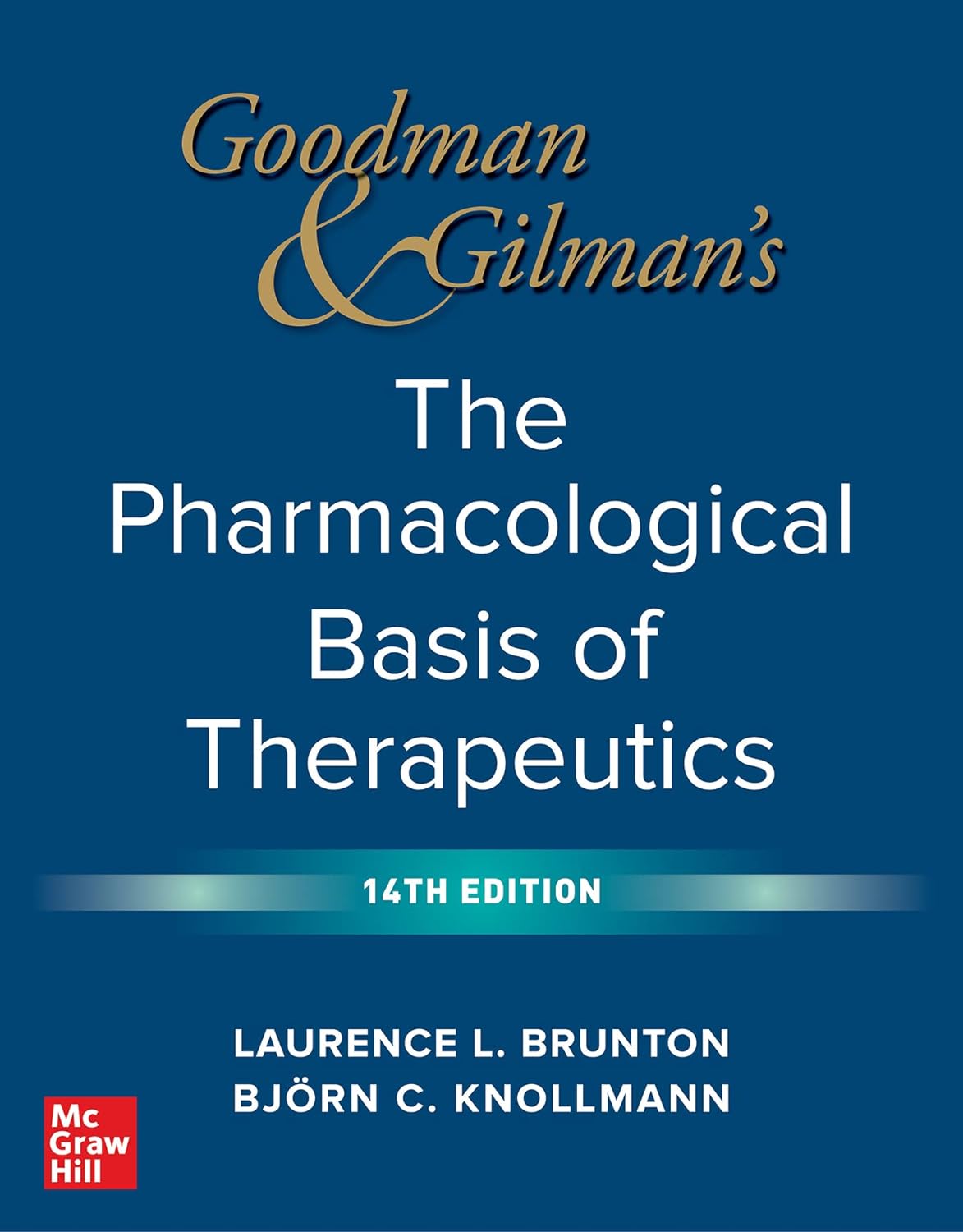The landmark pharmacology reference―updated to reflect the latest research and developments in the field
For more than 50 years, Goodman & Gilman’s: The Pharmacological Basis of Therapeutics has represented the pinnacle of authority and accuracy in describing the actions and uses of therapeutic agents in relation to physiology and pathophysiology. The text's careful balance of basic science and clinical applications has guided thousands of health care practitioners and students to a clear understanding of the drugs essential to preventing, diagnosing and treating disease.
This Fourteenth Edition includes five new chapters, 600+ illustrations, and important content from 53 new contributors.
More than a textbook, Goodman & Gilman’s is a working template for the effective and rational prescribing of drugs in daily practice.
Goodman & Gilman’s: The Pharmacological Basis of Therapeutics, Fourteenth Edition features:
- Pharmacovigilance
- The blood-brain barrier
- Cannabis
- Antibodies, immune checkpoint inhibitors, CAR-T cells, and other biological agents
- Gastrointestinal microbiome and drug response
Section I. General Principles
1. Drug Discovery: From Medicinal Plants to Computer-Aided Drug Design
2. Pharmacokinetics: The Dynamics of Drug Absorption, Distribution, Metabolism, and Elimination
3. Pharmacodynamics: Molecular Mechanisms of Drug Action
4. Membrane Transporters and Drug Response
5. Drug Metabolism
6. The Gastrointestinal Microbiome and Drug Response
7. Pharmacogenetics and Pharmacogenomics
8. Postmarketing Drug Safety
9. Principles of Clinical Toxicology
Section II. Neuropharmacology
10. Neurotransmission: The Autonomic and Somatic Motor Nervous Systems
11. Muscarinic Receptor Agonists and Antagonists
12. Anticholinesterase Inhibitors and Reactivators
13. Neuromuscular Junction and Autonomic Ganglia; Nicotine, Muscle Relaxants, and Spasmolytics
14. Adrenergic Agonists and Antagonists
15. 5-Hydroxytryptamine (Serotonin) and Dopamine
16. Neurotransmission in the Central Nervous System
17. The Blood-Brain Barrier and Its Influence on Drug Transport to the Brain
18. Drug Therapy of Depression and Anxiety Disorders
19. Pharmacotherapy of Psychosis and Mania
20. Pharmacotherapy of the Epilepsies
21. Treatment of Central Nervous System Degenerative Disorders
22. Hypnotics and Sedatives
23. Opioid Analgesics
24. General Anesthetics and Therapeutic Gases
25. Local Anesthetics
26. Cannabinoids
27. Ethanol
28. Drug Use Disorders and Addiction
Section III. Modulation of Pulmonary, Renal, and Cardiovascular
29. Drugs Affecting Renal Excretory Function
30. Renin and Angiotensin
31. Treatment of Ischemic Heart Disease
32. Treatment of Hypertension
33. Therapy of Heart Failure
34. Antiarrhythmic Drugs
35. Treatment of Pulmonary Arterial Hypertension
36. Blood Coagulation and Anticoagulant, Fibrinolytic, and Antiplatelet Drugs
37. Drug Therapy for Dyslipidemias
Section IV. Inflammation, Immunomodulation, and Hematopoiesis
38. Introduction to Immunity and Inflammation
39. Immunosuppressants, Immunomodulation, and Tolerance
40. Immune Globulins and Vaccines
41. Lipid-Derived Autacoids: Eicosanoids and Platelet-Activating Factor
42. Pharmacotherapy of Inflammation, Fever, Pain, and Gout
43. Histamine, Bradykinin, and Their Antagonists
44. Pulmonary Pharmacology
45. Hematopoietic Agents: Growth Factors, Minerals, and Vitamins
Section V. Endocrine Pharmacology
46. Introduction to Endocrinology: The Hypothalamic-Pituitary Axis
47. Thyroid and Antithyroid Drugs
48. Estrogens, Progestins, and the Female Reproductive Tract
49. Androgens and the Male Reproductive Tract
50. Adrenocorticotropic Hormone, Adrenal Steroids, and the Adrenal Cortex
51. Endocrine Pancreas and Pharmacotherapy of Diabetes Mellitus and Hypoglycemia
52. Agents Affecting Mineral Ion Homeostasis and Bone Turnover
Section VI. Gastrointestinal Pharmacology
53. Pharmacotherapy for Gastric Acidity, Peptic Ulcers, and Gastroesophageal Reflux Disease
54. Gastrointestinal Motility and Water Flux, Emesis, and Biliary and Pancreatic Disease
55. Pharmacotherapy of Inflammatory Bowel Disease
Section VII. Chemotherapy of Infectious Diseases
56. General Principles of Antimicrobial Therapy
57. DNA Disruptors: Sulfonamides, Quinolones, and Nitroimidazoles
58. Cell Envelope Disruptors: β-Lactam, Glycopeptide, and Lipopeptide Antibacterials
59. Miscellaneous Antibacterials: Aminoglycosides, Polymyxins, Urinary Antiseptics, Bacteriophages
60. Protein Synthesis Inhibitors
61. Antifungal Agents
62. Antiviral Agents (Nonretroviral)
63. Treatment of Viral Hepatitis (HBV/HCV)
64. Antiretroviral Agents and Treatment of HIV Infection
65. Chemotherapy of Tuberculosis and Nontuberculous Mycobacteria, Including Leprosy
66. Chemotherapy of Malaria
67. Chemotherapy of Protozoal Infections: Amebiasis, Giardiasis, Trichomoniasis, Trypanosomiasis, Leishmaniasis, and Other Protozoal Infections
68. Chemotherapy of Helminth Infections
Section VIII. Pharmacotherapy of Neoplastic Disease
69. General Principles in the Pharmacotherapy of Cancer
70. Cytotoxics and Antimetabolites
71. Protein Kinase Inhibitors and Pathway-Targeted Small Molecules
72. Antibodies, CAR T Cells, and Proteins to Treat Cancer
73. Hormones, Hormone Receptor Antagonists, and Related Agents in the Therapy of Cancer
Section IX. Special Systems Pharmacology
74. Ocular Pharmacology
75. Dermatological Pharmacology
76. Environmental Toxicology
Appendices
I. Design and Optimization of Dosage Regimens: Pharmacokinetic Data
II. Drug-Drug Interactions
Index


